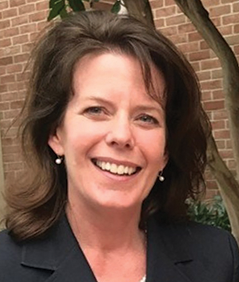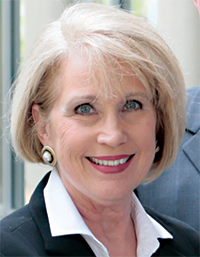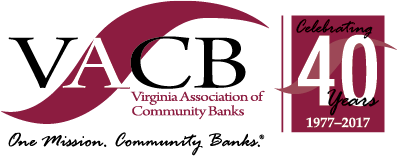Marking an anniversary
Community bankers banded together 40 years ago to remove barriers to growth
Marking an anniversary
Community bankers banded together 40 years ago to remove barriers to growth
In 1977, community banks were numerous across Virginia, but all of them were small, thanks to a state law then in effect that restricted their ability to expand beyond their local service areas.

This year, the VACB is celebrating its 40th anniversary, and community bankers say that its advocacy work in Richmond and Washington, D.C., is as critical as ever.

“They are really great at staying a step or two ahead on important topics and giving us information that is pertinent to what we might need on a day-to-day basis or for future business decisions. It frees up more of our time to focus on our customers,” she says.
Small banks now bigger
Virginia community banks have evolved quite a bit during the past four decades. That period saw a legislative loosening of restrictions on the size and geographic range that community banks could attain, along with two major real-estate bubbles that significantly altered the competitive and regulatory landscape.
Today, there are fewer community banks in Virginia, just 73, and they have gotten much bigger, a reflection of the consolidation trend that took hold in the aftermath of the Dodd-Frank Wall Street Reform and Consumer Protection Act of 2010, which added a mass of new regulatory requirements to all banks, regardless of size.

Aston’s bank expanded into the Richmond market in 2015 with its acquisition of Franklin Federal Savings Bank and this year announced a new merger with Paragon Bank, a $1.5 billion institution with three branches in North Carolina. When the merger is completed in January, TowneBank will have total assets of nearly $10 billion.
“We are centered around business lending and private banking, and so for us, any expansion needed to be into a somewhat larger metro market like Richmond and Raleigh rather than some of the other smaller communities in Virginia,” explains Aston, who adds that the overall expansion will allow TowneBank to grow at an annual rate of at least 8 percent. “That is very manageable but still gets us the returns that we need to have the right performance in our stock price.”
Crossing a threshold
Meanwhile, Union Bank & Trust, a once-tiny bank founded in Bowling Green in 1902, will soon be so big that it will cross the $10 billion threshold that technically differentiates a community bank from a regional bank. Its $701.2 million acquisition of Richmond-based Xenith Bankshares, scheduled to be completed in January, will take Union assets to more than $12 billion. That asset total will subject the bank to additional Dodd- Frank regulations, including the Durbin Amendment, which imposes a price cap on debit-card interchange fees and a more extensive stress test.
The deal, however, also will make Union Bank the first statewide independent Virginia bank since the 1990s, when major regional banks, such as Crestar, Sovran and Central Fidelity were sold. Once the deal is completed, Union Bank will have 111 branches in Virginia and North Carolina and 1,400 employees.

Asbury, a native Virginian and longtime banker, took over the reins at Union earlier this year after his most recent post running a $2 billion community bank in New Mexico. “With community banks come significant limitations on resources, on the ability to invest in technology, including cybersecurity, on the ability to attract talent, on the capital required to meet the needs of larger businesses,” he says. “The banking environment is a challenging place to be right now, and you don’t want to be too small.”
That was also the conclusion of the leadership of Richmond-based Eastern Virginia Bank (EVB), a Richmond-based bank, and Southern National Bank (Sonabank), based in McLean. Earlier this year, the two banks conducted a merger of equals. The new Richmond-based entity, known as Sonabank, has 44 branches in Northern and Central Virginia and Southern Maryland and $2.6 billion in assets.

HomeTown Bank has also grown significantly over its 12-year lifetime, but all of that growth has been organic. CEO Susan Still says that the bank’s smaller $550 million size has not been an issue. “I’m a big believer that you need to have banks of all sizes, and we’ve positioned ourselves as a smaller, boutique type of bank that is a nice alternative to the larger banks, and fortunately, there are plenty of customers that are looking for that type of alternative,” she explains.
Keeping a local feel
No matter how much community banks have grown, they’re all working hard to hang onto their high-touch, local orientation. In fact, it’s a top priority. “It still all comes down to local decision-making, responsiveness and flexibility,” says Asbury. “No one calls me from Charlotte or Atlanta and tells me what Union branches can and cannot do. We still pride ourselves on local knowledge and local connections. And I don’t ever want to lose that — no matter how big we get.”
Ironically, the Great Recession helped customers gain a greater awareness of and appreciation for community banks — and that’s allowing for new opportunities across all areas of the state.
“It kind of caused a renaissance for community banks, because all the media attention on banks helped people realize, ‘Hey, big banks are fine, but they’re not the only choice out there, and I kind of like the more personal touch,’” says Still.
Aston agrees. “There’s always going to be in my view the need for personal interaction and a relationship business in banking and that’s something that community banks will always be able to outperform their larger bank brothers on,” he says. “That’s not going away, even with all the technology that’s out there.”
In fact, as many superregional banks, including BB&T, are announcing branch closures to adjust to the fact that a growing numbers of their customers prefer to use digital platforms, community banks are going to be there to pick up the slack for those customers who still prefer a branch experience, especially in small towns, according to Steven Yeakel, VACB’s president and CEO.
“Community banks in large part are staying very well grounded within their communities,” he says. “We don’t see lots of moves out of local economies.”
For all of the challenges community banks are facing, most community bankers are optimistic about the future. VACB officials are hopeful that Congress will ease some of the regulatory burden on community banks, potentially by the end of the year. There is currently omnibus legislation pending in both the House and Senate to ease Qualified Mortgage (QM) lending rules for community banks; a new bipartisan bill introduced in June would raise the classification of community banks from $10 billion to $50 billion, which would give community banks more room to grow without changing the dynamics of how they’re viewed.
“Community banks are not going away,” says Aston. “In fact, it wouldn’t shock me to see another spurt of growth in new community bank startups over the next five years, after seeing virtually none over the past 10 years.”
r


















